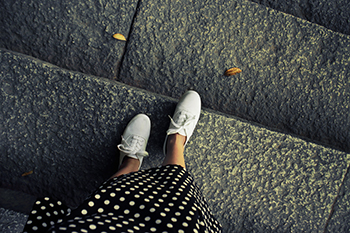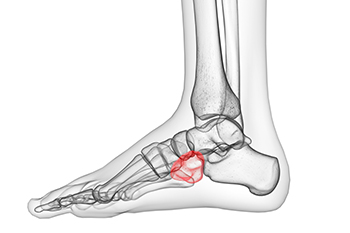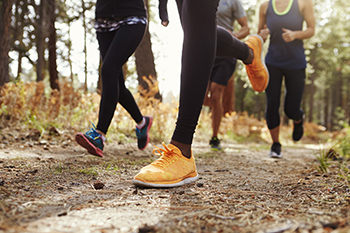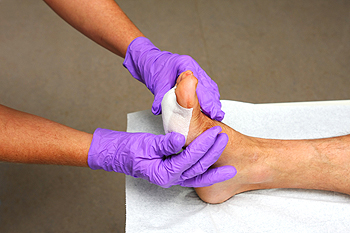Items filtered by date: November 2022
Safety Tips for Seniors Who Walk for Exercise

It is thought that as one ages, exercise becomes more beneficial to maintain a healthy body. One of the simplest ways to add exercise to your activity list is walking. It requires little in the way of equipment or special clothing, although proper footwear is important before starting. Walking paths and trails are prevalent in most areas. It is always a good idea to consult a doctor before undertaking any new exercise regimes. Walking may help build joint mobility and strength in the feet and ankles. It also helps with weight control, depression, and high blood pressure, experts say. Medical professionals suggest walking at a brisk pace for at least 15 minutes from three to five times a week for the best results. Safety tips include carrying a cell phone, going with a partner, and taking personal and medical identification with you. It also may be wise to use walking sticks to ensure that balance is maintained. It is a good idea to stop immediately if you feel breathless, have chest pain, or dizziness. For more information on the benefits and safety measures for walking, please consult a podiatrist.
Proper foot care is something many older adults forget to consider. If you have any concerns about your feet and ankles, contact one of our podiatrists from William Street Podiatry. Our doctors can provide the care you need to keep you pain-free and on your feet.
The Elderly and Their Feet
As we age we start to notice many changes in our body, but the elder population may not notice them right away. Medical conditions may prevent the elderly to take notice of their foot health right away. Poor vision is a lead contributor to not taking action for the elderly.
Common Conditions
- Neuropathy – can reduce feeling in the feet and can hide many life-threatening medical conditions.
- Reduced flexibility – prevents the ability of proper toenail trimming, and foot cleaning. If left untreated, it may lead to further medical issues.
- Foot sores – amongst the older population can be serious before they are discovered. Some of the problematic conditions they may face are:
- Gouging toenails affecting nearby toe
- Shoes that don’t fit properly
- Pressure sores
- Loss of circulation in legs & feet
- Edema & swelling of feet and ankles
Susceptible Infections
Diabetes and poor circulation can cause general loss of sensitivity over the years, turning a simple cut into a serious issue.
If you have any questions please feel free to contact one of our offices located in William Street in New York, NY, Forest Hills, NY, and Broadway in New York, NY . We offer the newest diagnostic and treatment technologies for all your foot and ankle needs.
Where Is the Cuboid Bone?

The cuboid bone is a short bone in the lateral or mid part of the foot. This bone acts as a pulley to a tendon in this part of the foot. When there is pain in this area, it is often from something called cuboid syndrome. This can occur from a disturbance with the articulation and joint involving this bone. Symptoms resemble ligament sprains, and pain can radiate into the foot. This syndrome is associated with other foot problems with this bone. Treatment can consist of manipulation of the cuboid bone, along with medial arch support. If you feel pain in this part of your foot, it is a good idea to consult with a podiatrist who can make a proper diagnosis and provide treatment options.
Cuboid syndrome, also known as cuboid subluxation, occurs when the joints and ligaments near the cuboid bone in the foot become torn. If you have cuboid syndrome, consult with one of our podiatrists from William Street Podiatry. Our doctors will assess your condition and provide you with quality foot and ankle treatment.
Cuboid syndrome is a common cause of lateral foot pain, which is pain on the outside of the foot. The condition may happen suddenly due to an ankle sprain, or it may develop slowly overtime from repetitive tension through the bone and surrounding structures.
Causes
The most common causes of cuboid syndrome include:
- Injury – The most common cause of this ailment is an ankle sprain.
- Repetitive Strain – Tension placed through the peroneus longus muscle from repetitive activities such as jumping and running may cause excessive traction on the bone causing it to sublux.
- Altered Foot Biomechanics – Most people suffering from cuboid subluxation have flat feet.
Symptoms
A common symptom of cuboid syndrome is pain along the outside of the foot which can be felt in the ankle and toes. This pain may create walking difficulties and may cause those with the condition to walk with a limp.
Diagnosis
Diagnosis of cuboid syndrome is often difficult, and it is often misdiagnosed. X-rays, MRIs and CT scans often fail to properly show the cuboid subluxation. Although there isn’t a specific test used to diagnose cuboid syndrome, your podiatrist will usually check if pain is felt while pressing firmly on the cuboid bone of your foot.
Treatment
Just as the range of causes varies widely, so do treatments. Some more common treatments are ice therapy, rest, exercise, taping, and orthotics.
If you have any questions, please feel free to contact one of our offices located in William Street in New York, NY, Forest Hills, NY, and Broadway in New York, NY . We offer the newest diagnostic and treatment technologies for all your foot care needs.
Arthritis Can Cause Pain in the Feet and Ankles
Why Do Blisters Develop on the Feet?

A blister is the body’s natural defense against skin that has become injured or burned. It appears like a small bubble that is filled with liquid and acts as a protective barrier between the skin and the environment until new skin has formed underneath it. Blisters develop for various reasons, including excess friction that happens from wearing shoes and socks that don't fit correctly, in addition to an allergic reaction from an insect bite. Some people have medical conditions that may produce blisters, including eczema and psoriasis. Possible infection may be avoided when the blister is not prematurely popped. The blister will gradually drain when the area is healed, and the skin will be a light pink until it returns to its normal color. It is advised that you consult with a podiatrist if you are afflicted with continuous blisters, who can advise you on what types of shoes to buy, or what you may be allergic to.
Blisters may appear as a single bubble or in a cluster. They can cause a lot of pain and may be filled with pus, blood, or watery serum. If your feet are hurting, contact one of our podiatrists of William Street Podiatry. Our doctors can provide the care you need to keep you pain-free and on your feet.
Foot Blisters
Foot blisters are often the result of friction. This happens due to the constant rubbing from shoes, which can lead to pain.
What Are Foot Blisters?
A foot blister is a small fluid-filled pocket that forms on the upper-most layer of the skin. Blisters are filled with clear fluid and can lead to blood drainage or pus if the area becomes infected.
Symptoms
(Blister symptoms may vary depending on what is causing them)
- Bubble of skin filled with fluid
- Redness
- Moderate to severe pain
- Itching
Prevention & Treatment
In order to prevent blisters, you should be sure to wear comfortable shoes with socks that cushion your feet and absorb sweat. Breaking a blister open may increase your chances of developing an infection. However, if your blister breaks, you should wash the area with soap and water immediately and then apply a bandage to the affected area. If your blisters cause severe pain it is important that you call your podiatrist right away.
If you have any questions, please feel free to contact one of our offices located in William Street in New York, NY, Forest Hills, NY, and Broadway in New York, NY . We offer the newest diagnostic and treatment technologies for all your foot care needs.
Tips for Healthy Trail Running

Most experts agree that running can improve your cardiovascular health, increase endurance, and boost mental well being. Experts have identified several ways to reap the rewards of trail running, which may involve uneven and sometimes unpredictable surfaces. The first thing to do is make sure you have footwear that is specifically designed for trail runs. These shoes provide the extra traction and specific cushioning needed as you may encounter rocks, tree roots, and streams. Second, your stride may need to be adjusted, which includes picking up your feet differently. While some road runners try to conserve energy by keeping their feet close to the ground, this can become a liability in trail running. Dirt can build up and actually slow the pace. Dehydration, muscle fatigue, glucose depletion, and inflammation can lead to injury. Fueling and hydrating before, during, and after runs is recommended. For more information on how to prevent injury while running, please consult a podiatrist.
Exercising your feet regularly with the proper foot wear is a great way to prevent injuries. If you have any concerns about your feet, contact one of our podiatrists of William Street Podiatry. Our doctors will treat your foot and ankle needs.
How to Prevent Running Injuries
Many common running injuries are caused by overuse and overtraining. When the back of the kneecap starts wearing out and starts causing pain in your knee, this is commonly referred to as runner’s knee. Runner’s knee is a decrease in strength in your quadriceps and can occur if you’re not wearing properly fitted or supporting shoes. To prevent runner’s knee, focusing on hip strengthening is a good idea, as well as strengthening your quads to keep the kneecaps aligned.
What Are Some Causes of Running Injuries?
- One cause of a common running injury is called iliotibial band syndrome.
- Plantar fasciitis is also another common injury.
- Stress fractures can occur from overtraining, lack of calcium, or even your running style.
Best Ways to Prevent Running Injuries
- Wear footwear that fits properly and suits your running needs.
- Running shoes are the only protective gear that runners have to safeguard them from injury.
- Make a training schedule. Adding strengthening exercises as well as regular stretching can help keep you strong and limber and can lessen the possibility of injuries.
- Stretching keeps muscles limber; this will help you gain better flexibility.
If you have any questions please feel free to contact one of our offices located in William Street in New York, NY, Forest Hills, NY, and Broadway in New York, NY . We offer the newest diagnostic and treatment technologies for all your foot and ankle needs.
What Are Arterial Ulcers?

An individual may develop a number of different kinds of wounds on their feet over the course of their lifetime. Diabetics are particularly prone to developing this kind of foot affliction. Arterial ulcers are a specific kind of wound that one ought to be aware of. This kind of wound is characterized by its rounded shape. Often these wounds will have very clearly defined lines around the affected area. In terms of location on the feet, arterial ulcers are usually found on the tips of toes and on the heels. While an individual with arterial ulcers may not experience any bleeding at the base of the wound, it is important to note that the wounds themselves are usually extremely deep. If you have an arterial ulcer, schedule an appointment with a podiatrist as these wounds can be highly painful. This foot specialist can help you mitigate and treat the problem.
Wound care is an important part in dealing with diabetes. If you have diabetes and a foot wound or would like more information about wound care for diabetics, consult with one of our podiatrists from William Street Podiatry. Our doctors will assess your condition and provide you with quality foot and ankle treatment.
What Is Wound Care?
Wound care is the practice of taking proper care of a wound. This can range from the smallest to the largest of wounds. While everyone can benefit from proper wound care, it is much more important for diabetics. Diabetics often suffer from poor blood circulation which causes wounds to heal much slower than they would in a non-diabetic.
What Is the Importance of Wound Care?
While it may not seem apparent with small ulcers on the foot, for diabetics, any size ulcer can become infected. Diabetics often also suffer from neuropathy, or nerve loss. This means they might not even feel when they have an ulcer on their foot. If the wound becomes severely infected, amputation may be necessary. Therefore, it is of the upmost importance to properly care for any and all foot wounds.
How to Care for Wounds
The best way to care for foot wounds is to prevent them. For diabetics, this means daily inspections of the feet for any signs of abnormalities or ulcers. It is also recommended to see a podiatrist several times a year for a foot inspection. If you do have an ulcer, run the wound under water to clear dirt from the wound; then apply antibiotic ointment to the wound and cover with a bandage. Bandages should be changed daily and keeping pressure off the wound is smart. It is advised to see a podiatrist, who can keep an eye on it.
If you have any questions, please feel free to contact one of our offices located in William Street in New York, NY, Forest Hills, NY, and Broadway in New York, NY . We offer the newest diagnostic and treatment technologies for all your foot care needs.


